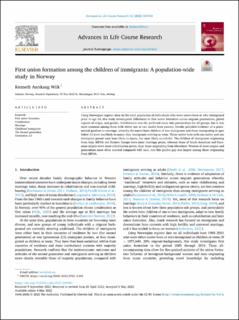| dc.contributor.author | Wiik, Kenneth Aarskaug | |
| dc.date.accessioned | 2022-08-09T08:36:05Z | |
| dc.date.available | 2022-08-09T08:36:05Z | |
| dc.date.created | 2022-05-05T09:56:32Z | |
| dc.date.issued | 2022-05 | |
| dc.identifier.citation | Advances in Life Course Research, Volume 52, June 2022, 100480 | en_US |
| dc.identifier.issn | 1569-4909 | |
| dc.identifier.uri | https://hdl.handle.net/11250/3010724 | |
| dc.description.abstract | Using Norwegian register data on the total population of individuals who were native-born or who immigrated prior to age 18, this study investigated differences in first union formation across migrant generations, global regions of origin, and gender. Cohabitation was the preferred route into partnerships for all groups, but it was most common among those with either one or two native-born parents. Results provided evidence of a generational gradient in marriage, whereby the native-born children of two immigrants and those immigrating in ages below 13 were less likely to marry than immigrants arriving as teens. Those native born with one native and one immigrant parent were least likely to marry, but most likely to cohabit. The children of immigrants originating from Asia, MENA and Eastern Europe were more marriage prone, whereas those of South-American and European origins were more cohabitation prone, than those originating from elsewhere. Women of most origins and generations more often married compared with men, and this gender gap was largest among those originating from MENA. | en_US |
| dc.language.iso | eng | en_US |
| dc.publisher | Elsevier | en_US |
| dc.rights | Navngivelse-Ikkekommersiell-DelPåSammeVilkår 4.0 Internasjonal | * |
| dc.rights.uri | http://creativecommons.org/licenses/by-nc-sa/4.0/deed.no | * |
| dc.title | First union formation among the children of immigrants: A population-wide study in Norway | en_US |
| dc.title.alternative | First union formation among the children of immigrants: A population-wide study in Norway | en_US |
| dc.type | Peer reviewed | en_US |
| dc.type | Journal article | en_US |
| dc.description.version | publishedVersion | en_US |
| dc.rights.holder | 2022 The Author(s). Published by Elsevier Ltd. This is an open access article under the CC BY licen | en_US |
| dc.subject.nsi | VDP::Samfunnsvitenskap: 200::Sosiologi: 220 | en_US |
| dc.source.volume | 52 | en_US |
| dc.source.journal | Advances in Life Course Research | en_US |
| dc.source.issue | June | en_US |
| dc.identifier.doi | 10.1016/j.alcr.2022.100480 | |
| dc.identifier.cristin | 2021660 | |
| dc.relation.project | Norges forskningsråd: 250486 | en_US |
| dc.source.articlenumber | 100480 | en_US |
| cristin.ispublished | true | |
| cristin.fulltext | original | |
| cristin.qualitycode | 1 | |

